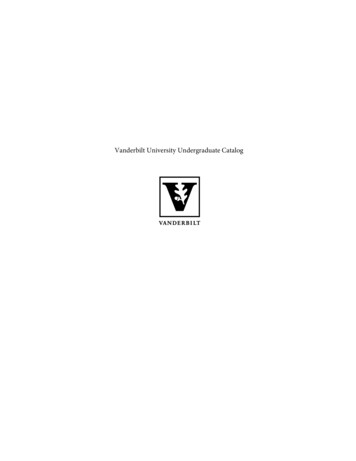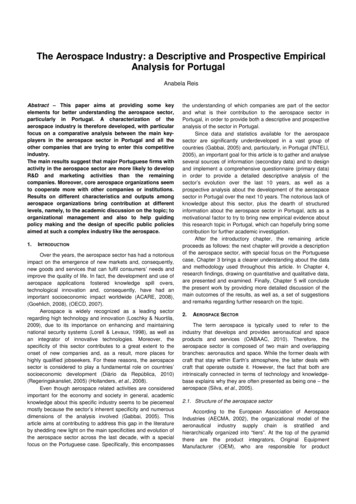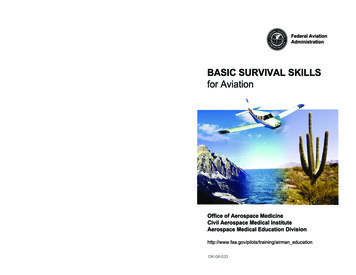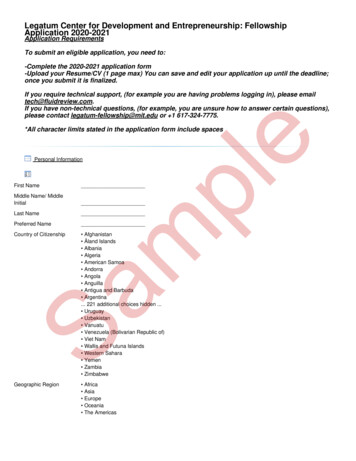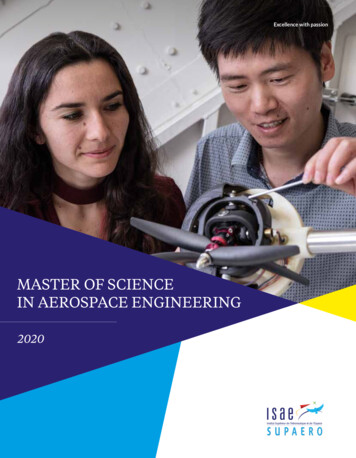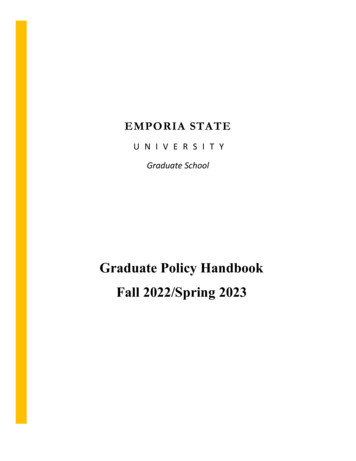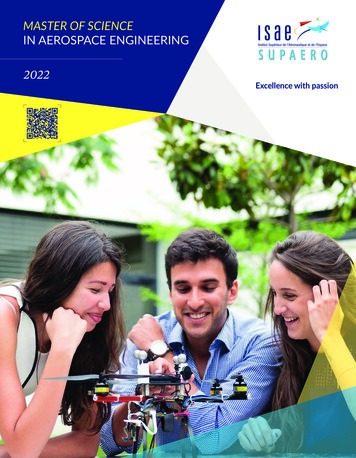
Transcription
MASTER OF SCIENCEIN AEROSPACE ENGINEERING2022Excellence with passion
ISAE-SUPAEROA world leader in aerospaceengineering higher educationA SPIRIT OF CONQUESTFROM THE VERY BEGINNINGCreated by ambitious, passionate scientists, SUPAERO was the very first aeronauticalengineering school in the world, founded more than 100 years ago. Today, our passion andour vision remain intact. They are our driving forces and they carry us forward in our questfor academic and scientific excellence. Over time, our graduates have contributed greatlyto the development of the aerospace sector, and ISAE-SUPAERO has benefited from asustained international reputation thanks to its engineers and the quality of its academicprograms and researchers. The wide range of programs and the many partnerships forgedwith the academic and industrial worlds have made ISAE-SUPAERO a point of referenceand a model to follow.A wide range of degree programs in aerospace engineering:33 programsMore than1800 students30% international students59 n ationalities are present on campusAn extensive, active international alumni network and well recognized graduates: I nventors: from the designer of the first jet aircraft to the inventor of the black box C EOs and high level executives at Airbus, Dassault, Safran, Thales, ATOS, AXA, IBM,and countless other industry leaders in France, Europe and all around the world D irectors of major programs such as Caravelle, Concorde, Airbus A320, Airbus A380and Airbus 350 Astronauts : Thomas Pesquet, Luca Parmitano and Jean-François Clervoy Many alumni work closely with space missionsAn exceptional environment in the heart of ToulouseEurope’s leading hub of aerospace industries, laboratories and universitiesA public higher education and research institution/2/
The ecological transitionat the heart of ISAE-SUPAERO’scommitmentAt ISAE-SUPAERO, we are convinced that Aviation connects people together and that Spaceis essential for communicating between continents and evaluating the condition of the planet.Both are at the cutting edge of technology, and their progress spills over into many otherareas. This is why we conduct research and train engineers and PhDs so they can invent theAeronautics and Space of the 21st century, and more generally to build the sustainable world oftomorrow.Aerospace engineers are now taking up a new extraordinary challenge: decarbonizing theaviation sector. To do so, new air transport will have to be invented, working with all aspects oftechnology and our engineers’ creativity.Focus on the Mermoz ProjectFaced with the climate emergency, aeronautics must be reinvented today.This will involve technological breakthroughs, of which hydrogen is one.This is why we are working on the design of a liquid hydrogen drone, theMERMOZ drone, capable of long distance flight with no CO2 emissions.ISAE-SUPAEROhas signed theGrenoble agreementsupported by theCOP2 Etudiantewhich aims toaccelerate theecological transitionof higher education.Through this innovative project, we are anticipating the changes thatwill affect the next generation of more environmentally-friendly aircraft.This project is already arousing a great deal of enthusiasm on the part ofour students, who are reminded of the days of the aviation pioneers anddiscovering new meaning for their future professional careers.Check out all our innovative projects inline with the ecological transition here/3/
The Master of Sciencein Aerospace EngineeringThe Master of Science is a two-yearprogram undertaken after undergraduatestudies, including Bachelor’s degrees or anequivalent. It provides higher qualificationfor employment or further doctoral studies.The ISAE-SUPAERO Master of Sciencedegree program is internationally renownedand highly regarded as an innovativeprogram in science and technologies.Fully taught in English, this program isdesigned to prepare engineering studentsto find and develop solutions to today’s andtomorrow’s challenges facing the world andthe aerospace industry.The Master is accredited by the FrenchMinistry of Higher Education and Researchin line with the European higher educationsystem./4/
OBJECTIVESLEARNING APPROACHThe Master of Science in Aerospace Engineeringis intended to educate graduate students insubjects relevant to the demanding challengesand needs of the industry.The ISAE-SUPAERO Master program is designedwith a combination of lectures, tutorials, studycases and projects to be performed in anindustrial environment or in ISAE-SUPAERO’slaboratories. It is taught in English.Giving students competences in engineeringscience, technology and design related toaeronautics and space, the MSc AE is designedto be multidisciplinary preparing future engineersto easily and efficiently work on aeronauticalsystems, space systems and their applications,with emphasis on the complete life cycle of thesystem. With a large spectrum of knowledgethe MSc AE allows students to tackle variousaspects from design to operations of productsand systems either in a research organism orin an aerospace company in a multinationalenvironment.The MSc AE program includes a three-semesteracademic session, on ISAE-SUPAERO’s premises,taught by permanent professors and expertsfrom the aerospace industry bringing currentknowledge and experience.The last semester consists in a master thesisto be prepared in a company or laboratory inthe aerospace sector. After the thesis, studentshaving obtained 120 credits under examinationwill be awarded the Master of Science inAerospace Engineering from ISAE-SUPAERO./5/
A multidisciplinarycurriculumFULLY TAUGHT IN ENGLISH4 SEMESTERS OF 30 ECTS EACHThe first semester of the Master of Science Aerospace Engineering program focuseson the common core curriculum, while the second semester offers a wide choice of electives.In the third semester, students choose one out the seven majors in the main areas of aeronauticaland space systems design.Students complete a master’s thesis in the fourth semester.1ST YEAR1ST SEMESTER2ND YEAR2ND SEMESTERCOMMON COREELECTIVE COURSESSciences & engineering,project management& systems engineering,foreign languages20 electives to broadenstudents’ horizonsin new areas3RD a choice of 7 areasof expertiseRESEARCH PROJECTStudents have extensive opportunities to developa scientific skills approach through research projectsin ISAE-SUPAERO laboratories in second and thirdsemesters along with on-the job skills duringinternships in the aerospace industrySUMMER INDUSTRYPLACEMENT(OPTIONAL)/6/4TH SEMESTERMASTER THESISIn a company ora research laboratory
Common coreThe core curriculum is multidisciplinary with a strong groundingin science and engineering, along with courses in project managementand foreign languages. During the third semester, it is split into two partsfocusing on space environment and mission or sustainable aviation.Fully taughtin EnglishSciences & EngineeringObjective 1: to master solid technical and scientific skills in the major disciplines related to aerospace engineeringAircraft systemsSpace systems Human factorsAviation safety airworthinessControl Aerodynamics & propulsion Flight dynamics Aeronautical structures Applied mathematicsAlgorithm and computingSignal processing Embedded systems Objective 2: to be aware of disciplines playing a major role in new aerospace projects Air and space law Sustainable aviation Climate sciencesProject Management & Systems EngineeringObjective: to develop a comprehensive, interdisciplinary approach to the design and development of a product or system Project management Systems engineeringForeign Languages and Soft SkillsObjective: to prepare students to work and communicate in evolving multicultural, team-oriented,innovative environments. French classes are mandatory for beginners during the two-year program.Languages: French as a Foreign Language, German,Arabic, Chinese, Spanish, Italian, Japanese, Portugueseand Russian Soft skills for innovation (innovation management &projects, creativity development, pitch conception,collective decision-making in situation of uncertainty,conferences with industrial actors in innovation) ElectivesResearch ProjectStudents select four electives among a choice of twentyProjects are a key component of the programand are designed to broaden students’ scientific,intellectual and social horizons.Acoustics – Mechanics of materials & structures –Space instrumentation – Object-oriented software development –Aircraft design methods Aeroengines Architecture & Performance – Aircraft structures –Control dynamic systems & implementation – Simulation for systemsengineering – Instrumentation & flight data analysis Experimental Approach in fluid dynamics – Computational solidmechanics – Signal processing and digital electronic basics –Systems architecture and programming – Adaptive controlThis research project features a graduate-levelresearch experience over 2 semesters witha focus on acquiring in-depth knowledge, expandingautonomy, and fostering innovation and criticalthinking. Software for CFD – Structures design project – Real time control ofan aerospace system – Cloud and network computing - MDO Beyond scientific excellence,ISAE-SUPAERO seeks to ensure qualityteaching in French as Foreign Languagefor its international students.The French as Foreign Language (FLE)Quality Label was obtained in December 2020,with the maximum score of 3 stars./7/
MajorsStudents focus on one of seven areas of expertise including:Advanced Aerodynamics & PropulsionAdvanced AerodynamicsAeroelasticity & Flexible Aircraft - Aeroelasticity part Aeroelasticity & Flexible Aircraft - Flexible Aircraft part Advanced Aerodynamics of Turbomachinery Numerical Fluid Mechanics Aeroacoustics Physics and Modelling Turbulence Multiphase Flow and Combustion Aerospace Systems and ControlMultiple-Input, Multiple-Output systemsControl of flexible structures Robust and optimal control Systems identification and estimation Non-linear control Hybrid control AI methods and tools for Automatic Control Aerospace Power Systems & Architecture Aircraft & Space Actuation Systems - Preliminary Design Model & Sizing of Aircraft Air-conditioning Systems Aerospace StructuresAeroelasticity & Flexible Aircraft - Aeroelasticity partAeroelasticity & Flexible Aircraft - Flexible Aircraft part Aerospace Structures - Advanced Structural Dynamics Part Aerospace Structures - Composite Structures in Services Part Computational Solid Mechanics Manufacturing Mechanics of materials Space Structures: spacecrafts & launchers Embedded SystemsArchitecture and Programming of Software SystemsReal-Time Systems Model-Based System Engineering Real-Time Networks AI and Autonomous Systems Architecture, Design and Synthesis of Hardware Systems System Dependability Certification /8/
Pathway AircraftDesign and Operation:Space SystemsSpace environment and effectsMission analysis and orbital mechanics Space communications systems Space project: tools for simulation Space systems architecture: ground segments,satellites & sub-orbital planes Launchers architecture Satellite propulsion: chemical & electrical Satellite AOCS Launchers guidance and control Satellite electrical systems On board data handling sub-systems: functions and architectures Satellite thermal control systems Estimation and filtering Space Imaging, Navigation and CommunicationFundamentals of electrical engineering Random signal processing and estimation Microwave and antenna engineeringSatellite communications and navigation Digital communications Land-mobile satellite transmission Satellite-based navigation Telecommunications and networksEarth observation Remote sensing and sensors Image processing and data analysisSystems EngineeringStudents in Aerospace Structures,Aerospace Systems & Control andSystems Engineering majors can followthe Aircraft Design and Operationpathway. In this case they attend twodedicated modules, in semester 2, andthey prepare their research project in thisfield.Masterthesis he Master thesis is preparedTeither in industry or in a laboratory.It enables the student to developdeeper knowledge, understanding,capabilities and attitudes.The overall goal of the thesis is forfor students to demonstrate theircapability to take up scientific orindustrial challenges successfully.Requirements EngineeringSystems Engineering Data Technical Management Systems Modelling and Analysis Systems Dependability Systems Design and Architecture Introduction to Verification & Validation AIRBUS study case:Systems Engineering & Certification of the A350 /9/
Acquiring researchexperiencePhD Track:Every year, several Master Graduates pursuePHD studies in our laboratories. MSc and PhDprograms can be connected in the frame of aPhD Track, supported by Toulouse School ofAerospace Engineering (TSAE).Research laboratories hoststudents to complete theirresearch projects400More thanresearchers on campus6doctoral schoolsAn international centerto host and train doctoralstudents/10/We are deeply committed to offering our students full accessto our research capabilities as well as academic and industrialpartnerships, covering the entire field of aerospace engineering.From a research policy point of view, the dual objective is tofoster the development of new knowledge as well as to answerthe needs of the aerospace industry. Our main research partnersare ONERA (the French Aerospace Lab.), LAAS-CNRS and OMP(Astronomical Observatory Midi-Pyrénées), the largest Frenchlaboratories in the engineering science and space fields. We havenumerous long-term research and development agreementswith the main European aerospace companies: Airbus, SAFRAN,Thales Alenia Space, Rockwell-Collins, MBDA and LiebherrAerospace. Reflecting our longstanding commitment to highereducation and research in the aerospace field, we are a memberof the management board of the Aerospace Valley cluster(550 aerospace companies and higher education and researchinstitutions from the Nouvelle-Aquitaine and Occitanie Regions).
/11/
World-class research facilities Autonomous system platform for micro-drones and robots Critical embedded systems platform Flight simulators and neuroergonomics platform Wind tunnels, aeroacoustics wind tunnel Turbofan Test Bed 6m high Drop tower, gas guns Fleet of 9 aircraft: TB 20, Robin DR 400, Vulcanair P68 Observer Software-defined radio room Clean rooms for satellite integration Ground station for satellite tracking and operation Satellite command and control center Additive manufacturing machineFlightsimulatorA multidisciplinary scientific policy:5 teaching and research departmentsThe Department of Aerospace VehiclesDesign and Control (DCAS)is a multi-disciplinary team structured in four researchgroups: Aircraft design Space systems design Decision and Control Neuroergonomics and human factorsDCAS covers a wide variety of problems includingguidance and navigation, collaborative unmannedvehicle control, astronauts psychophysiology duringorbital teleoperations, spacecraft trajectography andfuture aircraft architectures. Its unique resources includemotion flight simulators, a drone fly arena, and a fleet ofsingle-engine (TB-20 and DR400) and twin-engine (P68)aircraft used for flight experimentations.The four research groups collaborate in the following areas: Safer navigation and control of aerospace systems, Integrated multi-disciplinary aircraft design Advanced space concepts/12/Platform of autonomous systemsThe Aerodynamics, Energeticsand Propulsion Department (DAEP)is organized on the basis of three core research groups: Fundamental fluid dynamics External aerodynamics Turbomachines and PropulsionThe department works closely with the scientificcommunity on the Toulouse site and on joint researchprojects with French and international academicpartners, whether on a formal basis or based onresearcher-to-researcher connections. The departmentalso has research agreements and contracts withmajor aeronautics firms, equipment suppliers andsub-contractors.Aeroacoustics wind tunnel
lStructuratestsThe Department of Mechanicsfor Structures and Materials (DMSM)organizes and supervises all the teaching activitiesassociated with the mechanics of deformable solidsand structures for ISAE SUPAERO programs, in synergywith fundamental and applied research on aeronauticsmaterials and structures. Its team is made up ofprofessors, engineers, technicians and administrativestaff. The classes enable our students to gain skillsthat are closely aligned with the needs of the industryregarding material & structures disciplines but alsoto address new issues related to multi-disciplinaryor environmental considerations. The IntegratedTeam Project (ITP) addresses practical questions andsolutions to be managed in keeping with a researchand development methodology, in collaboration withspecialists in the industry and/or research or test centersthat are ISAE-SUPAERO partners, taking advantage ofthe synergy with the ICA (InstitutClément Ader).Three research topics are at the center ofthe activities at the DMSM: Durability & damage tolerance of compositeand metallic materials Modelling & qualification of aerospace structuresunder static or dynamics loadings Multiphysics Requirements-Driven Simulationand DesignSimulatiReal- on ModulTimeeEmbe for AircraddedftSysteThe Department of Electronics,msOptronics and Signal Processing (DEOS)develops and produces the payloads for the advancedaeronautics and space applications of tomorrow.Its team’s skills cover a wide range of technologies,from silicon sensors design to interplanetary sciencepayloads, and from theoretical signal studies toadvanced communication and navigation systems.The departement is organized into five core researchgroups: Micro Electronic Image Sensors Photonics, Antenna, Microwave and Plasma Navigation, Communication, Radar Communications and Information Theory Space Systems for Planetary ApplicationsThe Complex Systems EngineeringDepartment (DISC)at ISAE-SUPAERO develops knowledge in mathematicsand computer science for the aerospace industry.In education as in research, DISC is interested inmodels, methods and tools to master the behaviors andperformances of complex systems. This complexity maycome from the multiphysics or multiscale nature of thesystems, their dynamic behavior or their connected anddistributed structure.The department concentrates research driven in: Applied mathematics Communication networks Decision making systems Engineering for critical systemsAll 5 departments supporta micro-aerial vehicle developmentprogram on the international levelbased on student projects, research andinnovation projects, and internationalcompetitions.Orion spacecraftClean rooms/13/
Student ProjectsCNES AND ISAE-SUPAERO ARE PREPARINGSTUDENTS FOR A NEW ERA IN SPACEEXPLORATION THROUGH SPACESHIP FRThree students from the MSc Aerospace Engineering,Miriam Opazo Mendez (Spain), Elizaveta Shashkova(Russia), and Marcos Eduardo Rojas Ramirez(Mexico), Space Systems major, are part of theSpaceship FR Team at CNES (the French SpaceAgency).Their project consists in developing criticaltechnologies, providing students with an opportunityto design and build the future of Space Exploration.The Spaceship Initiative started at the EuropeanSpace Agency (ESA) and has gained support fromdifferent groups working on technologies for spaceexploration, especially those required for futuremissions to the Moon and Mars. The InternationalSpace Exploration Coordination Group (ISECG)has therefore created a roadmap for the criticaltechnologies necessary to carry out the plannedmissions, some of which CNES works on withinSpaceship FR. The team is working closely withSpaceship EAC (European Astronaut Center) locatedin Germany and Spaceship ECSAT (European Centrefor Space Applications and Telecommunications)located in the United Kingdom.Marcos (second-year student) was the first studentto work on the Spaceship FR project back inFebruary 2020 and is now working full-time on thisproject as part of his end-of-studies internship. Atthe moment, his role is to implement Model-BasedSystems Engineering (MBSE) tools and methodsto support System Engineering Activities acrossSpaceship FR. His research received an awardfrom the International Astronautical Federation’sEmerging Space Leaders Grant Programme, whichwill allow him to showcase his work, Spaceship FR,CNES, and ISAE-SUPAERO, at the International/1412/Astronautical Congress (IAC) to be hosted in Dubaiin October 2021.Miriam and Elizaveta (first-year students) joined theteam in February 2021 to develop the basis of theEnergy and Habitat subjects. Miriam has definedher work on Habitat as being at the intersectionof Habitable Structures, Interior Design, andEnvironmental Control and Life Support Systems(ECLSS). On the other hand, Elizaveta workson studying and providing information on newtechnologies linked to power production, powermanagement, and energy storage. At the same time,both of them get to use their knowledge to supporta project that aims to design and build an InflatableLunar Habitat.The Spaceship FR Team is mainly composed ofstudents guided by the project manager and otheradvisors depending on the subject. Thanks to apartnership between ISAE-SUPAERO and CNES, upto two students from the MAE Space Systems Majorcan work at Spaceship FR as part of their 13-monthresearch project every year. In the coming years,CNES is planning to build a structure at the ToulouseSite that can serve as a work space for the SpaceshipFR Team. This structure will have features similarto those of a Lunar or Martian Station and willallow the Spaceship FR team members to work andconduct their research. In this way, Spaceship FR andthe other Spaceship Teams will bring humankind onestep closer to building long-term habitats for humanexploration of the solar system while preparing anew generation of scientists and engineers.
HALE AEROECODESIGNThe second-year Master student from Spain, VictorGuadaño Martín, Aerospace Structures major, has beenworking on the HALE Aeroecodesign project. The mainobjective is to optimize the CO2 footprint of a solarpowered High Altitude Long Endurance (HALE) drone.In fact, a fully electric drone can still have an impacton the environment, mainly due to the materials used andthe way it is built. For this reason, the originality of this workis to include material choice from a discrete cataloguein the multidisciplinary design optimization (MDO)approach. The MDO approach consists in finding theoptimum interaction between different disciplines.The project was originally started by Edouard Duriez, aPhD student and was then taken over by Victor. With thesupervision of Edouard and Pr. Joseph Morlier (Departmentof Mechanics, Structures and Materials), his tasks consist inimproving both the complexity of the UAV model and theconvergence of optimizations for the tool created on thebasis of OpenAeroStruct. OpenAeroStruct is a lightweighttool that performs aerostructural optimization usingOpenMDAO, a NASA open-source framework for efficientmulti-disciplinary optimization.Also known as atmospheric satellites, HALE drones canprovide permanent coverage of a point or be repositionedwhen needed. They are repairable, unlike satellites that arein orbit. Their lower altitude can provide better resolutionfor earth observation, but it also results in smaller coverage.Their biggest advantage lies in their lower cost compared tosatellites. HALE drones may also be more environmentallyfriendly as they do not need high energy-consuming launcher.This advantage can be enhanced if special attention is paidto their environmental impact.According to Victor, it is interesting to look at a drone’s carbonfootprint. Indeed, a drone fueled by solar energy may lead usto think that its carbon footprint is zero, which turns out tobe inexact. He adds that it makes you reflect on the fact thateverything currently sold as electric and zero-emission maystill have a significant environmental impact due to otheraspects such as its manufacture.The whole project will culminate with a paper that Victorand his tutors hope to publish this year in the Structuraland Multidisciplinary Optimization Springer journal,an international peer-reviewed journal providing contentthrough innovative information, products and services.The tool they have created could be an excellent startingpoint for the preliminary design of new HALE drones. In thissense, with just a little input you can quickly obtain a realoptimized drone model, which can be very useful. Moreover,being an open-source tool based on OpenAeroStruct, anyonecan continue the work and add new components to themodel to obtain increasingly more complex and realisticresults. This could be an opportunity for future MAE studentsto continue with this project!/15/
ISAE-SUPAEROMSc’s GRADUATESWe have already trained more than 24 100 engineers who are contributingto the development of the aeronautics and space sector in France andaround the world. Our engineers’ vocation is to become future leaders inthe aerospace industry and the world of tomorrow. That is why we havedeveloped an integrated approach with training, research and innovationin partnerships with academic players, many industrial stakeholders anda network of the best international universities.ROSA ANGELICA CARDENAS SIERRAMEXICOAerospace Structures majorThe reason why I chose the MSc in Aerospace Engineering at ISAE-SUPERO isbecause it is a 2-year international program that gets you involved in research and/orprofessional environments with the possibility to adapt the academic plan according toyour personal interests. In my case, I selected the Structures Major and performed aninternship on Topology Optimization at Airbus.Afterwards, I was hired by the company as a Structure Analysis Engineer and sincethen, I have been collaborating in Research & Technology projects as well as In-Serviceactivities.Additionally, I am a temporary-professor at ISAE-SUPERO and in my free time Iperform non-profit volunteer activities to underscore the importance of education.HARI PRASATHINDIASpace Systems majorWhen I started applying for Masters, I was looking for a college that has a good coursestructure and also has well-established connections with industry. ISAE-SUPAEROis one such reputed university. I had the chance to connect with people from theindustry, which in time helped me to get my first job in the Space sector, despite theCovid situation. Specifically, I loved my space systems course as it covered almost allthe topics of space engineering and gave me a broader perspective of the field.I did my internship at a US startup company, working remotely from home. It dealtwith the effects of radiation exposure on DNA on the surface of the moon.Currently I am working as a scientific engineer in Stellar space studies. I wouldlike to continue and to progress in the space sector, with my career goalbeing to become a prominent player in the space sector in thefuture./16/
PALOMA GUINEA-GONZALVOSPAINSpace Systems majorSince I started my Bachelor in AerospaceEngineering, I was sure that I wanted todevelop my career in the space sector. I alsofelt very attracted by the idea of living a newexperience in a different country and growingin an international environment.After obtaining information about the variousoptions, I concluded that ISAE-SUPAEROwould be the perfect place to achieve mygoals. In the heart of the European aerospaceindustry, this Master seemed to me to be aunique opportunity to get into the sector andcontinue my education in a world-recognizedinstitution.In my view, one of the strongest points of theMaster is the direct contact with the aerospacesector and its actors. It is very useful andenriching to learn directly from researchersand workers from different companies andhave access to their experiences.I did my last semester internship at AirbusDefense and Space Toulouse. Thanks to thisopportunity, I was able to acquire significantexperience in many areas. I not only greatlywidened my technical knowledge andcompetences in the space sector, I also grewas a person in a professional environment,improving my soft skills and working as ateam player.After my graduation, I had the opportunityto work for GMV France in Toulouse. Andcurrently, I am working on GALILEO, theEuropean global navigation satellite system,as a performance engineer for the groundmission segment.In this sense, I am very satisfied with myefforts as I finally achieved my goal of workingon the space sector, doing a job where I canapply all the skills that I acquired during mystudies and where I can continue buildingmy professional career.FEDERICO BISCAROITALYSpace Imaging, Navigation andCommunication majorI chose ISAE-SUPAERO because the Masterhas a great combination of academic, researchand professional points of view, with a mix oflectures, interaction with PhD students, andlinks to amazing industrial partners thatare within reach in Toulouse. I also wantedto move to France for personal reasons, whilepursuing higher education studies.One of the strong assets of the MSc that comesto mind is the number of points of contact withthe post-graduation world. Plenty of lecturesare given by professionals - which can be a bitdisorienting at the beginning, but has lots ofadvantages. We also learn how to elaborateand present our work as students in a verymature way - thanks to the many practicalprojects that we have during the courses.Last but not least, it is an InternationalMaster: students create amazing bonds withpeople literally from all around the world. Inthe long run, we end up having true friends,research partners, colleagues who will pursuetheir career on different continents whilestaying in touch, and that is invaluable.Int
A multidisciplinary curriculum The first semester of the Master of Science Aerospace Engineering program focuses on the common core curriculum, while the second semester offers a wide choice of electives. In the third semester, students choose one out the seven majors in the main areas of aeronautical and space systems design. Students complete a master's thesis in the fourth semester.
